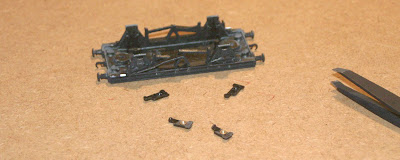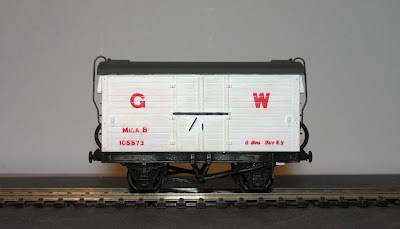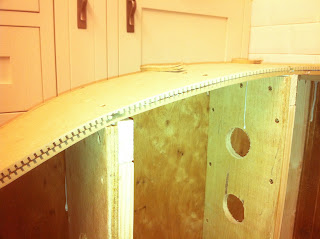What with the lingering cold weather, a busy family schedule and our rental house needing a complete redecorate, the layout has been on the back burner for a few weeks.
During this time though, I have managed to get the image file across to my friend Andrew Denholm, who has done a splendid job of printing a full size plot of the layout. This will be used as the template on which I will build the track. I mistakenly left in the shaded footprints of two Class 121s and a class 108, which were covering two of the turnouts. I will be need to print out the portions on an A4 sheet and tape them over the offending areas.
The plot arrived on Monday night and was duly unfurled on the floor to check it out, it happens to be millimetre perfect, more perfect then the boards cut by B&Q on they're super duper vertical saw table thingamajig!!
The plan was laid over the top sheet of the left baseboard, taped down and cut using a knife, thus leaving a mark on the board where the curved edge should be cut, the line being overmarked with a pencil. The plan was then taped to the inside face of the bottom sheet of the baseboard and the pencil line repeated.
I have not yet decided how I am going to cut the boards. Ideally I would clamp both boards together and cut them together allowing the both curves to match.
As can be seen in the picture above, I have achieved good results with my domestic (green, as opposed to the industrial blue) Bosch jig saw, which has a good range of blades to choose from, but the one problem I have is that when cutting anything over about 15mm the blade tends to bend a little, resulting in out of square cuts, seen below on the 25mm MDF that makes up my workbench.
The alternative would be to make a template using some spare laminate left over from a previous customers job to use with my router, the only difficulty being that the template needs to be cut 8.5mm inside the finished edge to allow for the offset created by the routers guide bush.
The end of our kitchen worktop was created in this way. I spent ages trying to find the centre of the radius on the curved unit and couldn't find one, it then dawned on me that there was no one single radius, but the curve was constantly changing template. (Who designs a kitchen unit without a fixed radius and supplies it without a template so that the kitchen fitter, in this case me, needs to make a bespoke template wasting time in the process??? (Rant Over!)) So I set to creating a template scribed from top of the actual unit, subtracting the 8.5mm clearance needed for the guide bush and came up with the result below.
As I am typing, the second option seems more and more like the one I need to pursue. It will take more time but it will mean that when trying to mate up the top and bottom boards with the bendy MDF side rail I will know that they are identical and won't have to faff about trying to match two bards that are out of square with one another.
Update to follow...





























.JPG)






.JPG)














